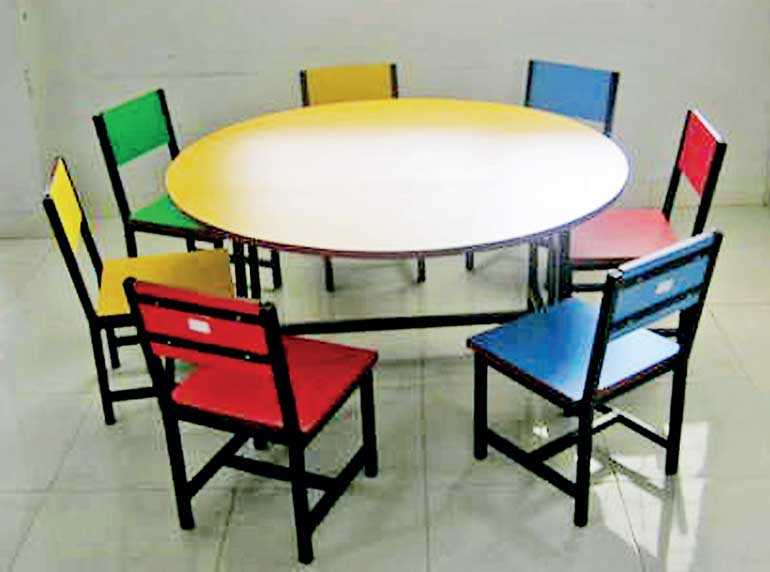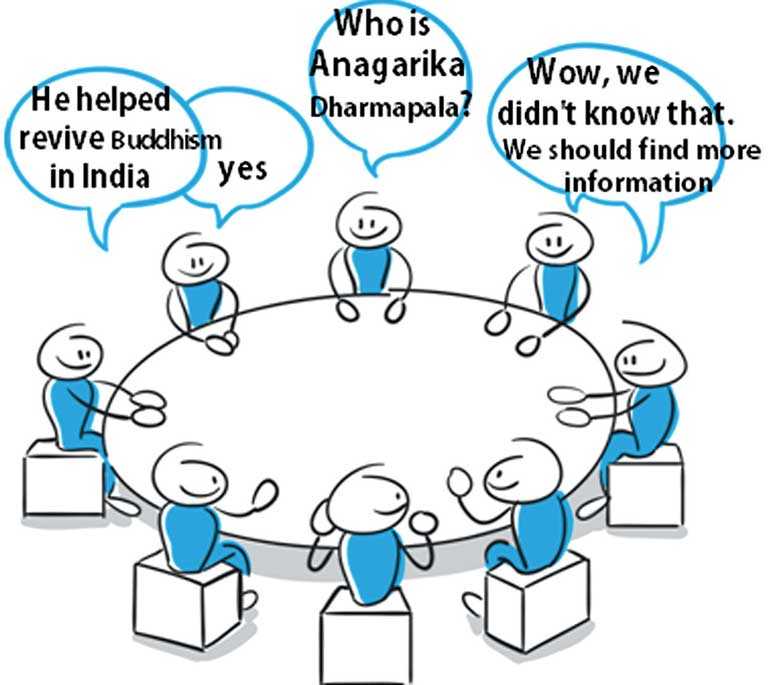Saturday Apr 05, 2025
Saturday Apr 05, 2025
Thursday, 12 December 2019 01:11 - - {{hitsCtrl.values.hits}}


Students learn from teachers in a school. Very few would argue with that statement. We have in our current school system a prominent place for the teacher; the front of the class with all students, one row after the row facing the teacher. This is the format for Grades 1 through 13 (till A/L) and even in the university format.
However, in pre-school (kindergarten) we have a different format. The students are arranged around a round table mostly. They are more or less in a circle. No teacher in front of the class explaining anything to them. Instead, there is more group based activities for them to actually learn.
Did you notice that this is also the same when it comes to professional workshops or conferences? The facilitator would not be the only one involved in the room. There would be group activities and majority of student/attendee participation. None of those who attend workshops attend by force, they actually pay and want to authentically learn from the facilitator and also learn from the peers who join in the workshop. This is same for the pre-school student. They learn mostly from one another rather than the teacher.
Would this same round table format work for Grades 1 to 13 then? 
Why are we trying to silence the students for 45 minutes while the teacher ‘attempts’ (very unsuccessfully we must admit) to teach a subject?
Is the curriculum addressed to teach in such an authoritarian manner?
Can the curriculum be replaced with a dogme concept of teaching?
Dogme is a teaching approach where you teach without textbooks or any prior preparation or reference to curriculum.
Questions like this don’t really have a binary answer. We need to really scratch our heads for a practical realistic solution that is not too complicated. What now?
A.S. Neill had a school called Summerhill where students could do whatever they wanted in class. Could this work? Close enough solution, but let’s bring in the invisible teacher to the classroom.
Who is a ‘Knowledge Invisible Teacher’ (KIT for short)?
KIT is one who acts like a facilitator in a workshop but also steps aside for the audience/students to work with each other and actually do the learning by themselves.
Where is the guidance and what happens to the given curriculum by the Ministry of Education?
Naturally, for such a system, the current curriculum needs to change. ISIS also needs to be in-effect (as discussed in earlier article on 28 November, Daily FT, page 16 titled ‘For an educated society: Using ISIS in Sri Lankan education system’).
ISIS – Individual Student Incorporated Schooling. Allocating students into a subject classroom where it’s dependent on the knowledge level rather than a Grade/Age level. One who are good in English might not be good in maths and vice versa. The one good in English would be put to a higher level classroom for English and a lower level one for maths, etc.
So we have students with equal knowledge for the subject sitting in a round table with an activity in hand that they need to solve as a group of 6. One child is having difficulty understanding part of the activity. The teacher is not nearby to help the child. Well the teacher should help the child, you might say in a disgruntled voice. But no, the teacher need not help. The other colleagues in the group will actually explain to the child.
Well, what happens to the group if all of them are unable to understand something? The teacher again does not help unless they are not able to proceed with the activity without answering the part. You will by now wonder whether the teacher is really doing anything in the class? You are right, if all goes to her/his plan, she/he should be made redundant.
The reason is simple. The solution is simple. The implementation is simple.
In the unsuccessful traditional teaching system, we have the teacher asking the questions and expecting the answers from the students. However, try to answer this:
If we put on one side a few teachers and on the other side students and if you were to ask a question and get the best answer, which of the two would you ask?
The ‘teacher’ would be the answer by the majority of respondents. So why then are we not asking the teacher? Why is it that the system is such that, it’s always the teacher asking questions? Is this why when children grow up in Sri Lanka, they are very shy to ask any questions during a panel discussion, conference or workshop, etc.
Okay, so let’s get to the so called simple solution and implementation:
First, the teacher has majority of the work not during the class but outside of the class. The teacher needs to prepare an activity that would cover the necessary knowledge that is needed to be acquired by the student. The teacher should also get flexibility to divert from the curriculum should a need arise. The activity would encompass the students working together to learn and challenge themselves.
Secondly, the students when faced with problems that the whole group are unable to answer, could put those as questions to the teacher on a piece of paper and submit at the end of the class. You heard it right, the students will be giving ‘homework’ for the teacher to answer! So a class of 18 would have three different sets of questions for the teacher to take as homework instead of 18 books to mark at home/after school.
No homework for the student! Well, not exactly. The teacher could be discreet about this part. The teacher might ask the students at the end of the class to come up (think of) with three to five questions each and submit to the teacher at the next class. So the student is actually taking the homework of the teacher. The student will not be engulfed with unnecessary similar questions to answers but spend less than 15 minutes to come up few questions, if at all. This would encourage the student to authentically learn the given activity. Coming up with questions for a certain topic is much harder than answering and would give a good footing for the student about the subject.
The current pedagogy needs to be upgraded to the new knowledge age, where memorisation is not the victor but the creative mind that can adapt to learn any knowledge base. Are we shaping our younger generation to think out of the box or are we pushing our children and locking them in a box? Let’s call in KIT then, it’s the least we could do for our next generation.
(p.s. – I am not happy about calling this the ‘Knowledge Invisible Teacher’ to be honest, since the word ‘teacher’ itself needs a new definition. If any of you can think of a better word for this ‘teacher’ mentioned above, do email me so that I can use the new word for future articles.)
(The writer is a former lecturer at University of Moratuwa, is an author of 25+ ICT books and founder of GTS, an educational game production company. He is currently reading for his PhD at General Sir John Kotelawala Defence University focusing on the thesis area of ‘creating a new education paradigm for Sri Lankan primary education system’. He can be contacted via [email protected].)
Discover Kapruka, the leading online shopping platform in Sri Lanka, where you can conveniently send Gifts and Flowers to your loved ones for any event including Valentine ’s Day. Explore a wide range of popular Shopping Categories on Kapruka, including Toys, Groceries, Electronics, Birthday Cakes, Fruits, Chocolates, Flower Bouquets, Clothing, Watches, Lingerie, Gift Sets and Jewellery. Also if you’re interested in selling with Kapruka, Partner Central by Kapruka is the best solution to start with. Moreover, through Kapruka Global Shop, you can also enjoy the convenience of purchasing products from renowned platforms like Amazon and eBay and have them delivered to Sri Lanka.
Discover Kapruka, the leading online shopping platform in Sri Lanka, where you can conveniently send Gifts and Flowers to your loved ones for any event including Valentine ’s Day. Explore a wide range of popular Shopping Categories on Kapruka, including Toys, Groceries, Electronics, Birthday Cakes, Fruits, Chocolates, Flower Bouquets, Clothing, Watches, Lingerie, Gift Sets and Jewellery. Also if you’re interested in selling with Kapruka, Partner Central by Kapruka is the best solution to start with. Moreover, through Kapruka Global Shop, you can also enjoy the convenience of purchasing products from renowned platforms like Amazon and eBay and have them delivered to Sri Lanka.